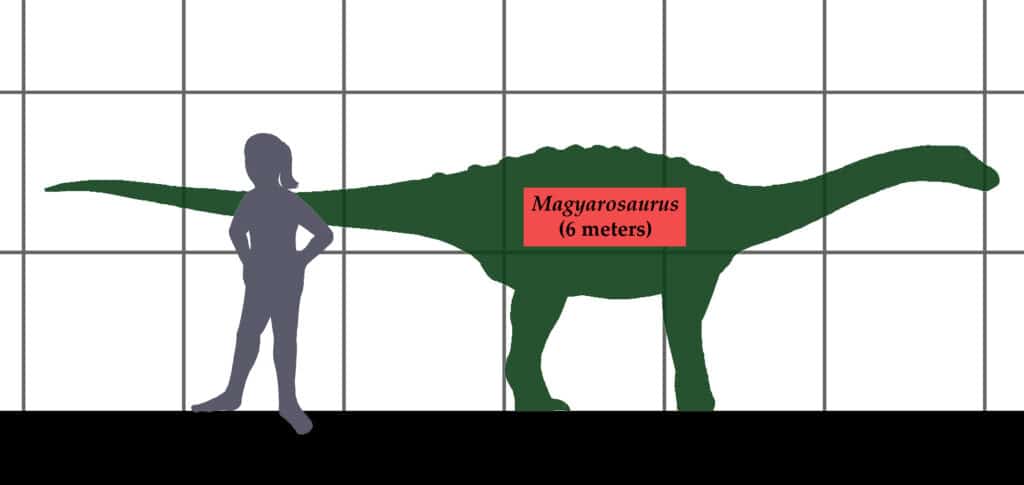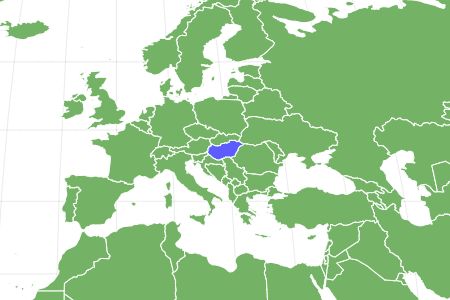Magyarosaurus is the smallest sauropod dinosaur to have ever lived
Advertisement
Magyarosaurus Scientific Classification
- Kingdom
- Animalia
- Phylum
- Chordata
- Class
- Reptilia
- Order
- Dinosauria
- Family
- Sauropoda
- Genus
- Magyarosaurus
- Scientific Name
- Magyarosaurus dacus
Read our Complete Guide to Classification of Animals.
Magyarosaurus Conservation Status
Magyarosaurus Facts
- Fun Fact
- Magyarosaurus is the smallest sauropod dinosaur to have ever lived
- Most Distinctive Feature
- Long neck and tail
- Distinctive Feature
- The dinosaur had a dermal armor on its back
- Habitat
- it lived on an island with sub-humid climate
- Predators
- Hatzegopteryx
View all of the Magyarosaurus images!
Sauropod dinosaurs are famous for their long necks and massive size. However, the Magyarosaurus is a typical exception to the rule. It was a dwarf sauropod dinosaur and is ranked as the smallest sauropod to have ever lived. This dinosaur lived from the early to late Maastrichtian Epoch of the Cretaceous Period. The small size of this dinosaur is an example of insular dwarfism caused by a limited food supply and a lack of predators because the species was isolated on an Island.
Description and Size

The Magyarosaurus had an unusual size for a sauropod dinosaur. It was the smallest sauropod, with an average height of about six feet.
©Conty / CC BY 3.0 – License
The name Magyarosaurus means “Magyar lizard,” a reference to a native Hungarian tribe known as the Magyar that originally occupied the area where this dinosaur was found. Only one species has been found so far, and it was named Magyarosaurus dacus. The specific name refers to the prehistoric Dacian people that lived in a part of present-day Romania about 2,000 years ago.
The Magyarosaurus had an unusual size for a sauropod dinosaur. It was the smallest sauropod, with an average height of about six feet. It was 20 feet long and weighed roughly 1,650–2,200 pounds. This is significantly low considering the biggest sauropods, such as the Argentinosaurus, were up to 80 tons, and the tallest, the giant Barosaurus, was up to 72 feet in height.
Despite the dwarfism of this dinosaur, it was still morphologically similar to other sauropods. They were quadrupedal with long necks and long tails. Experts also think Magyarosaurus might have had dermal armor with isolated osteoderm. This is a distinctive feature because this type of armor was rare in its relatives. The bony plates were irregularly shaped and came in different sizes.
The prevailing theory about this dinosaur’s dwarfism is that they exhibited a phenomenon known as insular dwarfism. This means that, unlike other sauropods, Magyarosaurus was a dwarf because of the limited food supply and the absence of large predators on the island where it was isolated.
Diet—What Did the Magyyarosaurus Eat?
Like the other sauropods, the Magyarosaurus was a plant eater. It fed on an exclusively plant-based diet which would have included the abundant tropical flora of its day. Even though it was relatively short, it could still browse leaves from the top of trees, and its neck was long enough to graze on grasses. This dinosaur would have been able to eat food out of reach of other animals in its native habitat. This allowed it to thrive better than other herbivores in the same area.
Habitat—When and Where Did the Magyarosaurus Live
Magyarosaurus lived 72 to 66 million years ago, which was the Maastrichtian Epoch of the Late Cretaceous Period. Scientists recovered remains of this animal on Hateg Island, indicating that Magyarosaurus lived an isolated life on this relatively small island. The region is now part of present-day Romania, even though it was part of Hungary.
Magyarosaurus lived in a predominantly subtropical climate. The island had a subhumid climate interspersed by seasonal precipitation. However, major environmental changes took place over time, transforming the region into an extensive wetland. Scientists think the limited nature of resources on this island contributed to the reduced size of the animals found here over the generations. This led to a localized form of dwarfism in the Magyarosaurus and many other animals found on the island.
Threats and Predators
Due to its size, the Magyarosaurus would have made easy prey for carnivorous predators. Fortunately, it didn’t live alongside a lot of big carnivores. The Hatzegopteryx was a large pterosaur that lived on the same island. It was the apex predator at the time and may have attacked the slightly smaller Magyarosaurus. Juveniles and eggs would have been at a big risk of predator attacks, but attacking adults would have been difficult.
Although this dinosaur was small, it had special characteristics that helped it protect itself. The presence of dermal plates was a major protection against predators. Also, Magyarosaurus‘ long tails could whip predators when swung from side to side, which is what they would have done in the face of danger.
Discoveries and Fossils—Where Magyarosaurus Was Found
Baron Nocsa first discovered Magyarosaurus fossils in 1915. Scientists found fossils belonging to at least 10 individuals of this genus in the Sânpetru Formation located in the Hunedoara region. The region is now in present-day western Romania, but it used to be a part of Hungary. Interestingly, despite finding many fossils, there was no skull remains at all. Recently, 14 fossil eggs were found in Romania and attributed to Magyarosaurus.
Extinction—When Did Magyarosaurus Die Out?
Magyarosaurus lived during the Maastrichtian Epoch, which was the last in the Cretaceous Period. The period ended about 66 million years ago with a major extinction event. Scientists agree that all the non-avian dinosaurs died off due to that event. Magyarosaurus was probably a victim, too, along with other mainland and island species of dinosaurs. Their demise allowed smaller mammals and reptiles to evolve into larger sizes.
Similar Animals to the Magyarosaurus
Similar Animals to the Magyrousarus include:
- Rapetosaurus — Rapetosaurus is a genus of titanosaurian dinosaur that was a close relative of the Magyrousarus. It probably lived towards the end of the Cretaceous Period too. They were similar in size, but the Repetosaurus had a more slender cranium and a larger build.
- Argentinosaurus — This sauropod dinosaur was on the other side of the size spectrum compared to the Magyarosaurus. It weighed up to 80 tons making it one of the largest dinosaur species ever discovered.
- Hatzegopteryx — This azhdarchid pterosaur lived on the same island as the Magyrosaurus. However, they exhibited island gigantism, which means they grew bigger than expected due to the abundance of prey. Scientists think they were the apex predator in this ecosystem.
Related Animals
View all 164 animals that start with MMagyarosaurus FAQs (Frequently Asked Questions)
When was Magyarosaurus alive?
Magyarosaurus lived in the Maastrichtian Epoch of the Late Cretaceous Period. This was about 72 to 66 million years ago. They probably died off during the Cretaceous-Tertiary mass extinction, which wiped out dinosaurs.
How big was Magyarosaurus?
Magyarosaurus was a dwarf dinosaur, so it was relatively small. An average Sauropod was almost seven times bigger than the Magyarosaurus. Magyarosaurus was roughly 6ft tall, 20ft long, and weighed about a ton.
Where was Magyarosaurus discovered?
Magyarosaurus fossils were found in the Hunedoara region. This area was formerly in Hungary before it is now in the present-day area in Romania, Europe.
What did the Magyarosaurus eat?
Magyarosaurus was a plant-eating dinosaur. It was a quadrupedal herbivorous dinosaur that lived in the dense tropical forest. The diet of this dinosaur probably included tropical trees and other shrubs within its height.
How many species of Magyarosaurus existed?
Friedrich von Huene named two other species of Magyarosaurus apart from Magyarosaurus dacus. The other two species’ names were Magyarosaurus transslyvanicus and Magyarosaurus hungaricus. However, only one species, Magyarosaurus dacus, is officially recognized. Magyarosaurus hungaricus was a bit larger than the typical Magyarosaurus dacus, making the researchers conclude that it existed when the island had a larger land area due to the lower sea level. Magyarosaurus dacus is the only verified species in the genus.
Thank you for reading! Have some feedback for us? Contact the AZ Animals editorial team.
Sources
- The Isle Wiki, Available here: https://isle.fandom.com/wiki/Magyarosaurus
- Wikipedia, Available here: https://en.wikipedia.org/wiki/Magyarosaurus
- Natural History Mueseum, Available here: https://www.nhm.ac.uk/discover/dino-directory/magyarosaurus.html

















